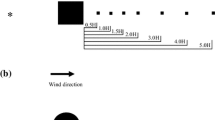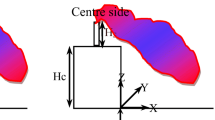Abstract
The flow and dispersion of stack-gas emitted from different elevated point source around flow obstacles in an urban environment have been investigated, using computational fluid dynamics models (CFD). The results were compared with the experimental results obtained from the diffusion wind tunnel under different conditions of thermal stability (stable, neutral or unstable). The flow and dispersion fields in the boundary layer in an urban environment were examined with different flow obstacles. Gaseous pollutant was discharged in the simulated boundary layer over the flat area. The CFD models used for the simulation were based on the steady-state Reynolds-Average Navier–Stoke equations (RANS) with κ–ɛ turbulence models; standard κ–ɛ and RNG κ–ɛ models. The flow and dispersion data measured in the wind tunnel experiments were compared with the results of the CFD models in order to evaluate the prediction accuracy of the pollutant dispersion. The results of the CFD models showed good agreement with the results of the wind tunnel experiments. The results indicate that the turbulent velocity is reduced by the obstacles models. The maximum dispersion appears around the wake region of the obstacles.
Similar content being viewed by others
References
Arya, S. P. (1999). Air pollution meteorology and dispersion. Oxford: Oxford University Press.
Fluent (2005). FLUENT 6.2.16 user manual. Lebanon, NH: Fluent.
Halitsky, J. (1963). Gas diffusion near buildings. ASHRAE Transactions, 69, 464–485.
Higson, H. L., & Griffiths, R. F. (1994). Concentration measurements around an isolated building: a comparison between wind tunnel and field data. Atmospheric Environment, 28(11), 1827–1836.
Huber, A. H. (1989). Video Images of smoke dispersion in the near wake of a model building. Part II. Cross-stream dispersion. Journal of Wind engineering and Industrial Aerodynamics, 32(1989), 263–284.
Isaacson, M. S., & Sandri, G. V. H. (1990). Laboratory study of pollutant detention times in wake cavities downwind of low-rise buildings. Journal of Wind engineering and Industrial Aerodynamics, 36, 653–663.
Launder, B. E., & Spalding, D. E. (1974). The numerical computation of turbulent flows. Computer Methods in Applied Mechanics and Engineering, 3, 269–289.
Macdonald, R. W., Griffiths, R. F., & Hall, D. J. (1998). A comparison of results from scaled field and wind tunnel modeling of dispersion in arrays of obstacles. Atmospheric Environment, 32(22), 3845–3862.
Mavroidis, I., & Griffiths, R. F. (2001). Local characteristics of atmospheric dispersion within building arrays. Atmospheric Environment, 35, 2941–2954.
Meroney, R. N., & Yang, B. T. (1971). Wind tunnel study on gaseous mixing due to various stack heights and injection rates above an isolated structure. CER71-72RNM-BTY16.
Meroney, R. N., Leitl, B., Rafailidis, S., & Schatzmann, M. (1999). Wind-tunnel and numerical modeling of flow and dispersion about several building shapes. Journal of Wind Engineering and Industrial Aerodynamics, 88, 333–345.
Mfula, A. M., Kukadia, V., Griffiths, R. F., & Hall, D. J. (2005). Wind tunnel modeling of urban building exposure to outdoor pollution. Atmospheric Environment, 39, 2737–2745.
Ogawa, Y., Griffiths, R., & Hoydush, W. G. (1974). A wind tunnel study of sea breeze effects. Boundary Layer Meteorology, 8, 141–161.
Patanker, S. V. (1980). Numerical heat transfer and fluid flow. New York, NY: McGraw-Hill.
Robins, A. G., & Castro, I. P. (1977). A wind tunnel investigation of plume dispersion in the vicinity of surface mounted cube-II the concentration field. Atmospheric Environment, 11, 299–311.
Saathoff, P. J., Stathopoulos, & Dobrescu, M. (1995). Effect of model scale in estimating pollutant dispersion near building. Journal of Wind Engineering and Industrial Aerodynamics, 54 & 55, 549–559.
Schulman, & Scire, J. (1991). The effect of stack height, exhaust speed, and wind direction on concentrations from a rooftop stacks. ASHRAE Transactions, 97(Part 2), 573–582.
Snyder, W. H. (1981). Guideline for modeling of atmospheric diffusion. EPA-600/8-81-009.
Snyder, W. H. (1993). Downwash of plumes in the vicinity of building a wind-tunnel study. Portugal: NATO Advanced Research Workshop.
Snyder, W. H., & Lawson, R. E. J. (1994). Wind-tunnel measurement of flow field in the vicinity of building. In Proceedings of the 8th AMS Conference on Applications of Air Pollution Meteorology, Tennessee.
Wen-Whai, L., & Meroney, R. N. (1983). “Dispersion near a cubical model building” Part I mean concentration measurements. Journal of Wind Engineering and Industrial Aerodynamics, 12, 15–33.
Wilson, D. (1979). Flow patterns over flat-roofed buildings and application to exhaust stack design. ASHRAE Transactions, 85(2), 284–295.
Wilson, D. J., & Britter, R. E. (1982). Estimates of building surface concentration from nearby point sources. Atmospheric Environment, 16, 2631–2646.
Wilson, D. J., & Lamb, B. (1994). Dispersion of exhaust gases from roof level stacks and vents on a laboratory building. Atmospheric Environment, 28, 3099–3111.
Yakhot, V., Orszag, S. A., Thangam, S., Gatski, T. B., & Speziale, C. G. (1992). Development of turbulence models for shear flows by a double expansion technique. Physics of Fluids A, 4(7), 1510–1520.
Yassin, M. F., Kato, S., Ooka, R., & Takahashi, T. (2002). Wind tunnel study of the flow and pollutant diffusion over an urban environment. In Proceedings of the 17th National Symposium on Wind Engineering, Tokyo, Japan, 4–6 Dec.
Author information
Authors and Affiliations
Corresponding author
Rights and permissions
About this article
Cite this article
Yassin, M.F. Study on gas diffusion emitted from different height of point source. Environ Monit Assess 148, 379–395 (2009). https://doi.org/10.1007/s10661-008-0168-y
Received:
Accepted:
Published:
Issue Date:
DOI: https://doi.org/10.1007/s10661-008-0168-y




